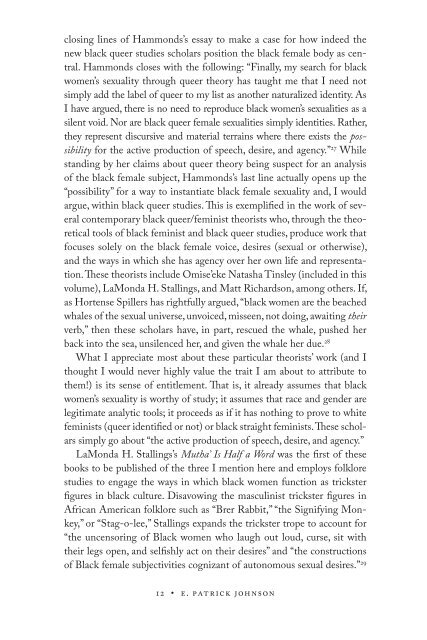No Tea
89AS6wvrf
89AS6wvrf
You also want an ePaper? Increase the reach of your titles
YUMPU automatically turns print PDFs into web optimized ePapers that Google loves.
closing lines of Hammonds’s essay to make a case for how indeed the<br />
new black queer studies scholars position the black female body as central.<br />
Hammonds closes with the following: “Fi nally, my search for black<br />
women’s sexuality through queer theory has taught me that I need not<br />
simply add the label of queer to my list as another naturalized identity. As<br />
I have argued, there is no need to reproduce black women’s sexualities as a<br />
silent void. <strong>No</strong>r are black queer female sexualities simply identities. Rather,<br />
they represent discursive and material terrains where there exists the possibility<br />
for the active production of speech, desire, and agency.” 27 While<br />
standing by her claims about queer theory being suspect for an analy sis<br />
of the black female subject, Hammonds’s last line actually opens up the<br />
“possibility” for a way to instantiate black female sexuality and, I would<br />
argue, within black queer studies. This is exemplified in the work of several<br />
con temporary black queer/feminist theorists who, through the theoretical<br />
tools of black feminist and black queer studies, produce work that<br />
focuses solely on the black female voice, desires (sexual or other wise),<br />
and the ways in which she has agency over her own life and repre sen tation.<br />
These theorists include Omise’eke Natasha Tinsley (included in this<br />
volume), LaMonda H. Stallings, and Matt Richardson, among others. If,<br />
as Hortense Spillers has rightfully argued, “black women are the beached<br />
whales of the sexual universe, unvoiced, misseen, not doing, awaiting their<br />
verb,” then these scholars have, in part, rescued the whale, pushed her<br />
back into the sea, unsilenced her, and given the whale her due. 28<br />
What I appreciate most about these par tic u lar theorists’ work (and I<br />
thought I would never highly value the trait I am about to attribute to<br />
them!) is its sense of entitlement. That is, it already assumes that black<br />
women’s sexuality is worthy of study; it assumes that race and gender are<br />
legitimate analytic tools; it proceeds as if it has nothing to prove to white<br />
feminists (queer identified or not) or black straight feminists. These scholars<br />
simply go about “the active production of speech, desire, and agency.”<br />
LaMonda H. Stallings’s Mutha’ Is Half a Word was the first of these<br />
books to be published of the three I mention here and employs folklore<br />
studies to engage the ways in which black women function as trickster<br />
figures in black culture. Disavowing the masculinist trickster figures in<br />
African American folklore such as “Brer Rabbit,” “the Signifying Monkey,”<br />
or “Stag- o- lee,” Stallings expands the trickster trope to account for<br />
“the uncensoring of Black women who laugh out loud, curse, sit with<br />
their legs open, and selfishly act on their desires” and “the constructions<br />
of Black female subjectivities cognizant of autonomous sexual desires.” 29<br />
12 • E. Patrick Johnson


